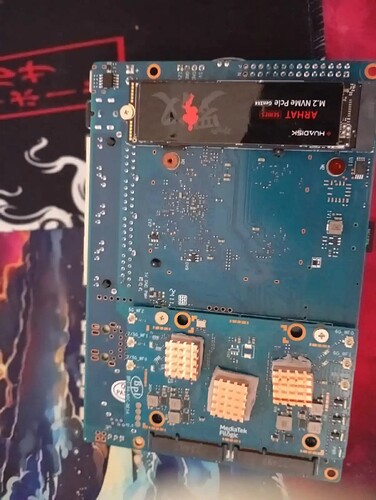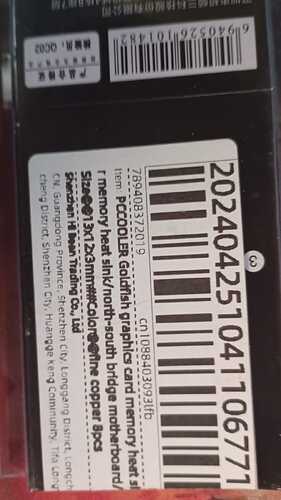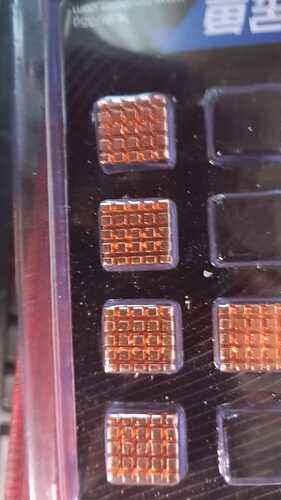You should know that they built this case as part of a heat-sinking system. Thermal transfer happens on the contact part (the thermal pad between the wireless module and the shield). If you drill holes in the bottom plate, then it would only reduce the area that could directly contact the shell - which reduces the efficiency of heat dissipation. What I suggest would just remove the contact part of the shield, and directly apply an active/passive heat sink on it.
For everyone who hasn’t gone this far, I suggest purchasing some tiny heatsinks from Amazon (Like those: https://www.amazon.ca/Awxlumv-Heatsink-25-x25-x10/dp/B08CMK8BMT) and directly pasting under the bottom, that will increase the area of heat transfer if you are afraid of getting overheat.
Good afternoon, I bought these and had to remove them from the box, they did not fit. I do not know what size the ones you have included are, but they should be very small.
Here are the measurements 13x12x3mm
Here is another photo
I think mine were smaller and when you close the box they don’t fit.
This is the heatsink that you buy on Aliexpress
Tape isn’t going to solve this, you literally ruined this case by removing almost half the thermal mass from the bottom board. Tape/plastic doesn’t conduct heat nearly as well as metal (I would assume aluminum in this case) does, the case is designed to be a heatsink, the bottom part/plate is essential to cool the BE14 card chips and you pretty much ruined its thermal conductivity. You need to replace the whole bottom plate or buy a new case entirely.
This is wrong, you shouldn’t put heatsink on top of the BE14 unless you are running the whole setup caseless.
The BE14 chips need to be fitted with thick thermal pads that will come directly into contact with the bottom of the case (assuming it’s intact).
In fact I don’t think the heatsinks in your picture are enough to cool the BE14 chips while running caseless, you would need them in tandem with active cooling.
Good morning @Mathieulh, thanks for your advice, because what I have done again has been to remove the cardboard and the tape, and that my refrigeration keeps them cold, don’t worry, if the bed14000 burns, it will be my responsibility.
Thanks for your wise advice,
Regards
Speaking of thermal pads for the BE14 chips, is there any official info on pad thickness? I tried to measure the gap between the chips and the bottom plate of the chassis with a feeler gauge, but other components were getting in the way.
Here he talks about the thermal pads used in the BE14 WiFi 7 module:
Thermal pad comparison to know which one to buy:
Hey guys! sorry if i shouldve spend more than an hour looking for answer, but i just finaly setup my R4 (with latest snapshot OpenWrt SNAPSHOT r30262-c5c894f7ff) and the thing is just bearable to the touch (+30c ambient) when idle (full official package with a super quiet fan, aluminum case, wifi7, thermal pads touching case fine) “root@OpenWrt:~# cat /sys/class/thermal/thermal_zone0/temp 66660” Is this normal? i did see mentions of some thermal fixes for drivers - but didn’t quite understand. are there any fixes? does my latest firmware misses any? what can i do (apart from fixing a giant fan to it since i would like it to be a travel router)
Thanks in advance!
![]() travel router …
travel router … ![]()
This is one solution:
I’m sorry for this …
Try to look into this too:
i feel like facepalming myself)))
it looked promising online to have modern futureproof and flexible router/server/media/download station all in one ![]()
thanks for you suggestions. but if heat production can not be toned down - i would probably just sell it. sure its powerfull, but i doubt some decent power management couldn’t be achieved on those modern chips if right people are on it. Sorry if im being too naive, but assume some driver updates could improve situation a lot (since it heats to 60c the whole alu case without any load just with upstream wifi connection established and no traffic).
So to phrase my question better: is there any work done or being done on impoving openwrt efficiency on this hardware, any tricks, settings, packages or firmwares to improve power management. Or at least any hope?)
Probably i’m not in the right topic, but any help appreciated! Thanks in advance)
You can try this:
People have reported that ASIA RF’s AW7916 (WiFi 6E) works:
BPI-R4 and WiFi 7 are currently under development. You need to understand that there are different versions of OpenWrt: one from OpenWrt directly, and another customized by Banana Pi.
This product isn’t like a Raspberry Pi, which is frequently used for development and has very strong software support.
Instead, for the BPI-R4, the development focus is primarily on the board itself.
→ You have to read much about BE14 … ![]()
Thank you for your answers ![]()
- Does that mean, that wifi 7 card is more of a problem heat production wise than main processor and “upgrading” to that 6e card will work much cooler?
- Do you know of any openwrt firmware for it which preforms better power management wise that openwrt snapshot for bpi-r4 so i can start from decent place?
Thanks again!
Also, i have https://www.aliexpress.com/item/1005007264405047.html lying around. Any chance it could work?
- Wi-Fi 7 generally needs more power (not sure about idle).
- The Banana Pi BE14 shows a value of “14000” — power consumption?
- The AsiaRF AW7991 shows “5000” and consumes 11.5 W!
→ The BE14 does not include an eFEM. → Some boards have issues with the EEPROM.
There’s a lot to read in OpenWrt forum and bananapi forum ![]()
So, i can not expect be14 work efficiently and reliably as a consumer device. And no firmware, config or driver update can help this now or in the future. (glueing piece of copper to it is not on the cards)))) Also my cheapo AX210 adapter is not supported.
Probably best to sell it then and spend more time configuring my keenetic. Wish i wouldve know this sooner)
Ive seen some tests online stating low power consumption for the main board and efficient transmissions for be14 and decided to have a bday present))) but didnt dig deep enough ![]() Thanks a lot!
Thanks a lot!
I.
“So, I can not expect the BE14 to work efficiently and reliably as a consumer device.”
→ It was never meant for that!
But you can get close to it. ![]()
The question is: why are you here?
→ If you’re an OpenWRT enthusiast, software developer, case builder or maker — you’re in the right place! ![]() → But if you’re looking for a Wi-Fi 7 router that works out of the box — this is not the right place.
→ But if you’re looking for a Wi-Fi 7 router that works out of the box — this is not the right place.
II.
“And no firmware, config or driver update can help this now or in the future.”
The software-related “unpleasantries” of the R4 will be solved — but probably over the next few years.
As I said, there are two paths you can choose:
- The BananaPi version with MediaTek SDK (OpenWRT has its own fork for that):
![]() [Banana BPI-R4] all related to MTK-SDK - Community Builds, Projects & Packages - OpenWrt Forum
[Banana BPI-R4] all related to MTK-SDK - Community Builds, Projects & Packages - OpenWrt Forum
- Or the version from the BananaPi site:
- Or OpenWRT with open source drivers:
![]() https://firmware-selector.openwrt.org/
https://firmware-selector.openwrt.org/
III.
Wi-Fi 7 is still very new for the open source community. If you’re expecting a rock-solid OpenWRT + Wi-Fi 7 experience — you’re a bit early. → But there are people actively developing the open source drivers right now!
That’s why I asked about your needs.
In my own case, I might need a 6 GHz Wi-Fi 7 setup — but definitely not a BE14000 ![]() with serious issues.
with serious issues.
Let me give you a quick comparison:
 The AsiaRF AW7916 (Wi-Fi 6E) is an AX3000
The AsiaRF AW7916 (Wi-Fi 6E) is an AX3000 The AsiaRF AW7990 (Wi-Fi 7) is a BE3600
→ See the difference?
The AsiaRF AW7990 (Wi-Fi 7) is a BE3600
→ See the difference?
If you compare the power consumption of the R3 and R4 (with Wi-Fi module), you’ll have some serious questions… → And yes, it’s about Wi-Fi! (And SFP+ if you use it.) It’s unacceptable for me, personally!
BUT – the good news is:
You can choose which Wi-Fi module or SFP module you want to use ![]() .
.
Oh so there is a chance that it would work better with mediatek sdk or banana pi rom - i will try that. thanks for the links!
Answering to your question: im fine with some tinkeing and exploring openwrt but im not a wifi/linux enthusiast and dont even own any wifi7 devices. the only 6ghz device i have is made by meta so not allowed to access the internet and also 6ghz+ range is reserved by military here in ukraine, so probably a good thing that wifi adapter has poor range and i hopefully wont get a missile in my window)))
as i can better see now that purchase was a mistake as pi5+some ax210/be200 would serve my needs better i think, but at the time of purchase as i was frustrated that my keenetic router torrent client leaked around vpn tunnel , lacked proper configuration tools, issues with AFP stability and dlna performance R4 seemed like an ultimate solution for many years forward so i went for it. Probably dumb but since i have it now - im looking for ways to actually use it and main culprit is heat at the moment. i understand that if i can touch it electronics are fine, but such a bad efficiency deeply bugs me. i also put gpon stick into it and that thing i can not touch for more than a split second even though i havent even put a cable into it…
i dont want to buy asiarf because their shipment to ukraine more than doubles the price and im not sure i want to invest another 100$ into that box of fire…
if there is a chance that drivers get better or some mainstream wifi cards get support- we may remain friends, but you mentioned that it lacks some hardware aspects to be a great consumer component, so probably always will be a compromise if im not mistaken ![]() and that takes away from my enthusiasm
and that takes away from my enthusiasm ![]()
thanks again for your time and effort to answer my stupid questions, btw!
ive got some more if your kindness is not tested hard here))
are there any other wifi cards supported?
are there any gpon sticks not pretending to be a a space heater? how to know which would work fine?
![]()





